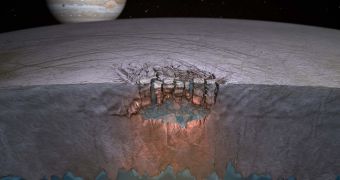According to a scientific paper published in the latest issue of the top journal Nature, it would appear that massive volumes of water are trapped under the surface of Europa, one of the most interesting moons around Jupiter.
The data were extracted from a series of observations that NASA spacecraft carried of the gas giant and its moon over the past couple of decades. Scientists now estimate that the amount of water that can be found under Europa's ices is equal to that of the Great Lakes separating the United States and Canada.
Scientists believe that the link between the thick, icy shell surrounding the moon and the ocean beneath is made up of significant material exchanges, which is what led them to this conclusion in the first place. The main implication this research has is that life may be possible elsewhere in the solar system.
In recent studies, it has been determined that Earth's hadal zones (the deep ocean) can be made into proxies for analyzing the probability of life developing on moons such as Europa, or Saturn's Enceladus. The likelihood of that happening appears to be very large.
However, another significant implication is that life may develop in environments such as these throughout the entire galaxy, and potentially in all galaxies as well. The number of ice-covered planets is way larger than that of second Earths, basic statistics show.
“The data opens up some compelling possibilities. However, scientists worldwide will want to take a close look at this analysis and review the data before we can fully appreciate the implication of these results,” NASA Headquarters Astrobiology Program director Mary Voytek explains.
In the case of Europa, the need for more missions around the moon is as clear as day. The NASA Galileo spacecraft managed to infer the existence of a massive saltwater ocean under the thick ice crusts. Experts believe that the ocean contains more water than all of Earth's seas combined.
“One opinion in the scientific community has been if the ice shell is thick, that's bad for biology. That might mean the surface isn't communicating with the underlying ocean,” University of Texas in Austen Institute for Geophysics postdoctoral fellow Britney Schmidt explains.
“Now, we see evidence that it's a thick ice shell that can mix vigorously and new evidence for giant shallow lakes. That could make Europa and its ocean more habitable,” adds Schmidt, the lead author of the Nature paper.
As if anticipating the new findings, the National Research Council (NRC) proposed a mission to Europa as its second-most important priority for the next decade. As a result of the recommendation, NASA is currently starting to investigate what it would take to launch such a spacecraft.
“This new understanding of processes on Europa would not have been possible without the foundation of the last 20 years of observations over Earth's ice sheets and floating ice shelves," Institute of Geophysics senior research scientist Don Blankenship concludes.

 14 DAY TRIAL //
14 DAY TRIAL //